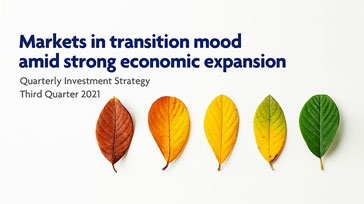Key Points
- Wall Street indices rebound from Monday’s drop to mount new highs
- Investors will be looking at earnings reports and Fed statement this week
- Asia: Multiple 2Q GDP reports coming out this week; overhang over China techs
The major Wall Street indices closed the week (19-23 July) at new highs with the S&P 500 chalking up a weekly advance of 2% for a 17% gain since the start of the year. The Dow which fell more than 700 points last Monday rebounded to close above 35,000 for the first time for a 1% weekly gain and up more than 14% this year.
The tech-focused Nasdaq Composite meanwhile added 2.8% for its strongest weekly advance since April. Across the Atlantic, the Stoxx Europe 600 index which had its worst session of the year on Monday with a 2.3% drop, also recovered to close the week higher by 1.5%.
Equity investors had taken their cues from the bellwether 10-year US Treasury yield which fell to a five-month low of 1.13% early Tuesday over concerns of the spread of the coronavirus Delta variant derailing the global recovery. However, the course soon reversed when the benchmark yield started to bounce back (1.28% on Friday) prompting stocks to rally.
That change in direction was also driven to a large part by strong earnings from tech stocks during the week which indicated that there is still steam in the US recovery that is backed by a new high in the preliminary manufacturing PMI (63.1 for July vs 62 for June) from IHS Markit.
Twitter rose 3% and Snapshot shot up by 24% on Thursday following better-than-expected second-quarter earnings. That also helped to lift Facebook by more than 5% (and its market cap to cross $1 trillion) and Alphabet by 3% which along with the other Big Techs – Apple, Amazon, Microsoft and Tesla – will be among those releasing their 2Q earnings this week.
Intel which also released its earnings however fell by 5.3% despite beating estimates but its forward guidance was dampened by concerns over chip supply and margins. American Express also reported better-than-expected quarterly results, giving its shares a 1.3% boost on the back of a rebound in US credit and debit card spending.
Of the 15% of the S&P 500 companies that have reported earnings, 88% have beaten earnings estimates, according to Refinitiv. Profit margins have also held up with companies reporting average profit margins of 12.8% so far for the second quarter which is above the historic range, according to S&P Global.
Other than the Big Techs, the week ahead will also earnings reports from Big Pharma companies such as Pfizer, AstraZeneca, GlaxoSmithKline, Merck; financial services such as Visa, MasterCard, PayPal and consumer related companies like 3M, McDonald’s, Procter & Gamble, Colgate-Palmolive and Hilton Worldwide – which will give investors a better gauge of earnings momentum and health of the US economy.
Communications services were the best performing sector (+3.2%) the past week followed by tech (+2.8%), consumer discretionary (+2.9%) with industrials and material lagging but still eking fractional gains. Hence it may be interesting to see if growth stocks will extend the leadership for a fifth week over value and cyclical this week.
US data for this week include figures for unemployment claims, new home sales and prices, durable goods and consumer confidence but more importantly also US GDP, advanced economic indicators and personal consumption expenditures (PCE) preferred by the US Fed as an inflation signpost.
The Fed begins a 2-day meeting on Tuesday to be followed by a statement and Fed Chair Jerome Powell briefing. Later in the week will also see the St. Louis Fed President James Bullard and Fed Governor Lael Brainard speaking out.
Meanwhile, talks will restart in Washington DC over the raising of the US debt ceiling to meet the annual fiscal budget, while discussions will continue over President Joe Biden’s $1.2 trillion bipartisan infrastructure bill.
Over in Asia, the coming days will see the release of 2Q GDP figures from South Korea (UOB estimate +5.6% y/y vs 1.9% in 1Q); Hong Kong (UOB est +7.7% vs +7.9% in 1Q); Taiwan (UOB est +7.6% vs +8.92% in 1Q) as well as China’s official July PMIs which according to a Bloomberg poll will likely see the manufacturing PMI ease to 50.8 (from 50.9 in June) while non-manufacturing may rise to 53.7 (from 53.5 in June).
IHS Markit has meanwhile downgraded its global 2021 growth forecast by 0.2 percentage points to 5.8% over how the Delta variant may impact global economic recovery citing the link to vaccination for growth prospects for 2021 and 2022. It should be noted however that Indian equities have been an outperformer despite the spikes in Covid-19 cases.
Meanwhile, there is still nervousness over how far Chinese regulators will go to rein in tech companies whose performances have been dented by regulatory scrutiny with the latest clampdown extended from the likes of Alibaba, JD and Didi to online education companies.
This publication shall not be copied or disseminated, or relied upon by any person for whatever purpose. The information herein is given on a general basis without obligation and is strictly for information only. This publication is not an offer, solicitation, recommendation or advice to buy or sell any investment product, including any collective investment schemes or shares of companies mentioned within. Although every reasonable care has been taken to ensure the accuracy and objectivity of the information contained in this publication, UOB Asset Management Ltd ("UOBAM") and its employees shall not be held liable for any error, inaccuracy and/or omission, howsoever caused, or for any decision or action taken based on views expressed or information in this publication. The information contained in this publication, including any data, projections and underlying assumptions are based upon certain assumptions, management forecasts and analysis of information available and reflects prevailing conditions and our views as of the date of this publication, all of which are subject to change at any time without notice. Please note that the graphs, charts, formulae or other devices set out or referred to in this document cannot, in and of itself, be used to determine and will not assist any person in deciding which investment product to buy or sell, or when to buy or sell an investment product. UOBAM does not warrant the accuracy, adequacy, timeliness or completeness of the information herein for any particular purpose, and expressly disclaims liability for any error, inaccuracy or omission. Any opinion, projection and other forward-looking statement regarding future events or performance of, including but not limited to, countries, markets or companies is not necessarily indicative of, and may differ from actual events or results. Nothing in this publication constitutes accounting, legal, regulatory, tax or other advice. The information herein has no regard to the specific objectives, financial situation and particular needs of any specific person. You may wish to seek advice from a professional or an independent financial adviser about the issues discussed herein or before investing in any investment or insurance product. Should you choose not to seek such advice, you should consider carefully whether the investment or insurance product in question is suitable for you.





